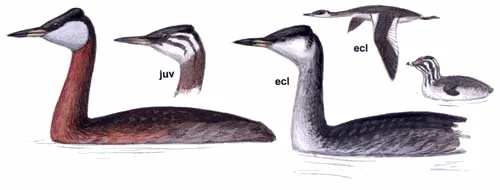
Red-necked Grebe
[order] PODICIPEDIFORMES | [family] Podicipedidae | [latin] Podiceps grisegena | [UK] Red-necked Grebe | [FR] Grebe jougris | [DE] Rothals-Taucher | [ES] Somormujo de Cuello Rojo | [NL] Roodhalsfuut
Subspecies
| Genus | Species | subspecies | Breeding Range | Breeding Range 2 | Non Breeding Range |
| Podiceps | grisegena | NA, EU | widespread | ||
| Podiceps | grisegena | grisegena | n, c Eurasia | sw Asia, s and w Europe, n Africa | |
| Podiceps | grisegena | holbollii | ne Asia, n North America | China, Japan, s USA |
Physical charateristics
A medium-sized grebe with a long, heavy bill and thick neck, the Red-necked Grebe is the only grebe with a distinct red neck and a white chin in breeding plumage. Breeding plumage is characterized by a dark body, red neck, white cheeks, and black crown. Juveniles and adults in non-breeding plumage are an overall grayish-brown.
Listen to the sound of Red-necked Grebe
[audio:http://www.aviflevoland.nl/sounddb/R/Red-necked Grebe.mp3]
Copyright remark: Most sounds derived from xeno-canto
| wingspan min.: | 58 | cm | wingspan max.: | 62 | cm |
| size min.: | 40 | cm | size max.: | 46 | cm |
| incubation min.: | 20 | days | incubation max.: | 23 | days |
| fledging min.: | 65 | days | fledging max.: | 23 | days |
| broods: | 1 | eggs min.: | 3 | ||
| eggs max.: | 6 |
Range
North America, Eurasia : widespread
Habitat
Red-necked Grebes are found in distinctly different habitats at different times of year. During summer they nest on large freshwater lakes, sloughs, and reservoirs. They prefer areas with stable water levels and require emergent vegetation to anchor their floating nests. During winter they are found predominantly on salt water, most commonly in protected bays, marshes, and coasts. However in winter they can also be found miles offshore.
Reproduction
Red-necked Grebes build their nests in shallow water with marsh vegetation. Both male and female help build a floating nest made of plant material and anchored to emergent vegetation. Typically, the female lays two to four eggs. Some nests have many more eggs, but it has been suggested that these large clutches are the product of more than one female. The young are fed by both parents and often ride on their backs. Shortly after hatching, they can swim by themselves.
Feeding habits
In the winter small fish make up most of the diet. In summer insects become more important as a food source.
Conservation
This species has an extremely large range, and hence does not approach the thresholds for Vulnerable under the range size criterion (Extent of Occurrence <20,000 km2 combined with a declining or fluctuating range size, habitat extent/quality, or population size and a small number of locations or severe fragmentation). Despite the fact that the population trend appears to be decreasing, the decline is not believed to be sufficiently rapid to approach the thresholds for Vulnerable under the population trend criterion (>30% decline over ten years or three generations). The population size is very large, and hence does not approach the thresholds for Vulnerable under the population size criterion (<10,000 mature individuals with a continuing decline estimated to be >10% in ten years or three generations, or with a specified population structure). For these reasons the species is evaluated as Least Concern.
Podiceps grisegena is a widespread breeder across much of central, eastern and northern Europe, which accounts for less than a quarter of its global breeding range. Its European breeding population is relatively small (<56,000 pairs), but was stable between 1970-1990. Although there were declines in countries such as Ukraine and Poland during 1990-2000, other sizeable populations in Russia and Finland were stable or increased, and the species declined only slightly overall.
This bird has a wide distribution in the boreal regions of Eurasia and North America. Within the European Union it is known as a breeding species only from Scotland, where its population amounts 60 breeding pairs. The total northern European population is estimated at 6000-9000 breeding pairs and winters mainly along the coasts of the North Sea and on the central European lakes. A few birds reach the Mediterranean coasts. Despite important local fluctuations, the total population of this species seems quite stable.
Podiceps grisegena is a widespread breeder across much of central, eastern and northern Europe, which accounts for less than a quarter of its global breeding range. Its European breeding population is relatively small (<56,000 pairs), but was stable between 1970-1990. Although there were declines in countries such as Ukraine and Poland during 1990-2000, other sizeable populations in Russia and Finland were stable or increased, and the species declined only slightly overall.
This bird has a wide distribution in the boreal regions of Eurasia and North America. Within the European Union it is known as a breeding species only from Scotland, where its population amounts 60 breeding pairs. The total northern European population is estimated at 6000-9000 breeding pairs and winters mainly along the coasts of the North Sea and on the central European lakes. A few birds reach the Mediterranean coasts. Despite important local fluctuations, the total population of this species seems quite stable.

Migration
Migratory and dispersive. After breeding, most migrate or disperse to tidal water. In west Palearctic principal wintering areas western seaboard (Norway and Britain to Bay of Biscay), Baltic and Caspian Sea; lesser numbers also Black Sea and north Mediterranean. 19th century reports of large numbers Morocco and Tunisia, but no modern confirmation and seems now scarce to rare winter visitor to south side Mediterranean. Some winter inland waters, especially larger ones such as Swiss Lakes. Present British coastal waters chiefly October-March. Main spring departures from western seaboard March, from Caspian Sea April; breeding waters reoccupied late March to early May, averaging earlier in west.
Distribution map

